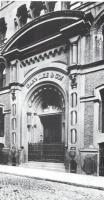
Charles Allen Du Val
His life and works
Daniel Lee
Daniel Lee 1798-1877 was a leading Roman Catholic layman in Manchester. Born in Salford, the son of an Irish veterinary surgeon, he was educated at Sedgeley Park School and lived at Springfield House in Pendleton.
In 1819 he started work in the calico printing trade, and in 1826 became a partner in Wright & Lee, calico printers. On the death of Edmund Wright of Mauldeth Hall in 1852, Daniel Lee became the sole proprietor and the firm changed its name to Daniel Lee & Co. Lee was a very active local Liberal politician, a councillor from 1844 to 1848, and a magistrate from 1838. He was a major benefactor to Roman Catholicism, and gave £1,000 towards the building of Salford Cathedral (1844-48), where there is the Lee chantry chapel (1). In 1865 he became president of the Roman Catholic Registration Society that had been formed in Manchester (2).
The business of Daniel Lee & Co. was essentially that of calico printing. The firm had no works of their own, but commissioned printed goods from other factories. In evidence given to the Select Committee on Copyright of Designs in 1840 he said that about half the business was in the production and sale of printed goods, the rest being "Calicoes in various shapes, and nankeens and those things; it is called a general warehouse; we are general dealers." (3)
His warehouse (now demolished) was on the corner of Spring Gardens and Fountain Street in the centre of Manchester. It was a brick and stone-dressed structure, built in 1856 to the design of architect Edward Salomon (1828-1909). "It had a most remarkable stone entrance, cut so hard and crisp as to make it look almost like cast iron, with columns literally immured in the frame of the entrance and carrying a ‘monstrous curved pediment’ without which, said the Builder, ‘this would have been the handsomest warehouse in Manchester – and that is saying much for any structure’." (4)
By 1855 the high quality of the goods produced by the firm had become very well established abroad. In that year a report appeared of their success at the Universal Exposition in Paris : “As regards individual exhibitors in the Manchester department the most remarkable, both for the excellence and novelty of the results, is that of Messrs. Daniel Lee & Co. This consists of Cashmere Furnitures printed in some fourteen “colours,†by cylinder. The result is an effect in many respects superior to block printing, since there is a softness of effect combined with precision, to which the best examples of block work rarely attain. These specimens stand alone in the exhibition and have attracted great attention on the part of technical men. The French associate this invention with that of Mr. Burch as applied to the printing of Brussels carpets, of which numerous specimens are exhibited by the firm of which Mr. Burch is a partner, - Bright & Co. Indeed we are strongly inclined to think that the process of Messrs. Daniel Lee & Co. is of a very similar character to, if not identical with, that employed in the printing of carpets; the varied tints being obtained by a species of dilution upon an analogous principle to the mode pursued in the execution of a water-colour drawing, though of course differing very materially in the mechanical method.†(5).
Daniel Lee employed from six to eight designers in house, producing 2500 designs per year, and also purchased some 750 designs per year. The designs were for high quality textile goods and furniture, mostly for export. They were not concerned about their designs being pirated: Daniel Lee considered that tracing a copy was "more tedious and unpleasant" than designing an original (6), and his firm had a vast turnover in designs to keep pace with changing fashions (7). One of their free-lance designers was (briefly) Charles Allen Du Val, but his designs proved impossible to print, and Lee found a better use for his genius in portrait painting.
(1) The Cotton Masters, 1830-1860 by Anthony Howe (1984) page 71.
(2) Chronological Record from the Creation to the Present Time by Daniel O'Gorman (1865) page 420.
(3) Reports from Committees : Twelve Volumes : (3) Copyright of Designs : Session 16 January - 11 August 1840 Volume VI (1840) pages 252-274. The expert evidence given by Daniel Lee is summarised in The Mechanic's Magazine, Museum, Register, Journal and Gazette volume 33 (1840) pages 391-394. His evidence was lampooned in The Policy of Piracy, quoted in The Literary Gazette and Journal of the Belles Lettres, Arts, Sciences, &c. for the Year 1841 (1841) page 145.
(4) Manchester : an Architectural History by John J. Parkinson-Bailey (2000) page 82.
(5) The report appeared under the title The Artistic, Industrial, and Commercial Results of the Universal Exposition of 1855 by George Wallis in The Art-Journal New Series Volume I (1858) page viii. Joseph Burch, the inventor and carpet printer, had his portrait painted by Charles Allen Du Val. The picture is now in the Science Museum in South Kensington, London.
(6) Grand Designs: Labor, Empire and the Museum in Victorian Culture by Lara Kriegel (2007) page 76.
(7) Reports from Committees : Twelve Volumes : (3) Copyright of Designs : Session 16 January - 11 August 1840 Volume VI (1840) page 252 et seq. The firm did however register some of their designs at the Patent Office.

